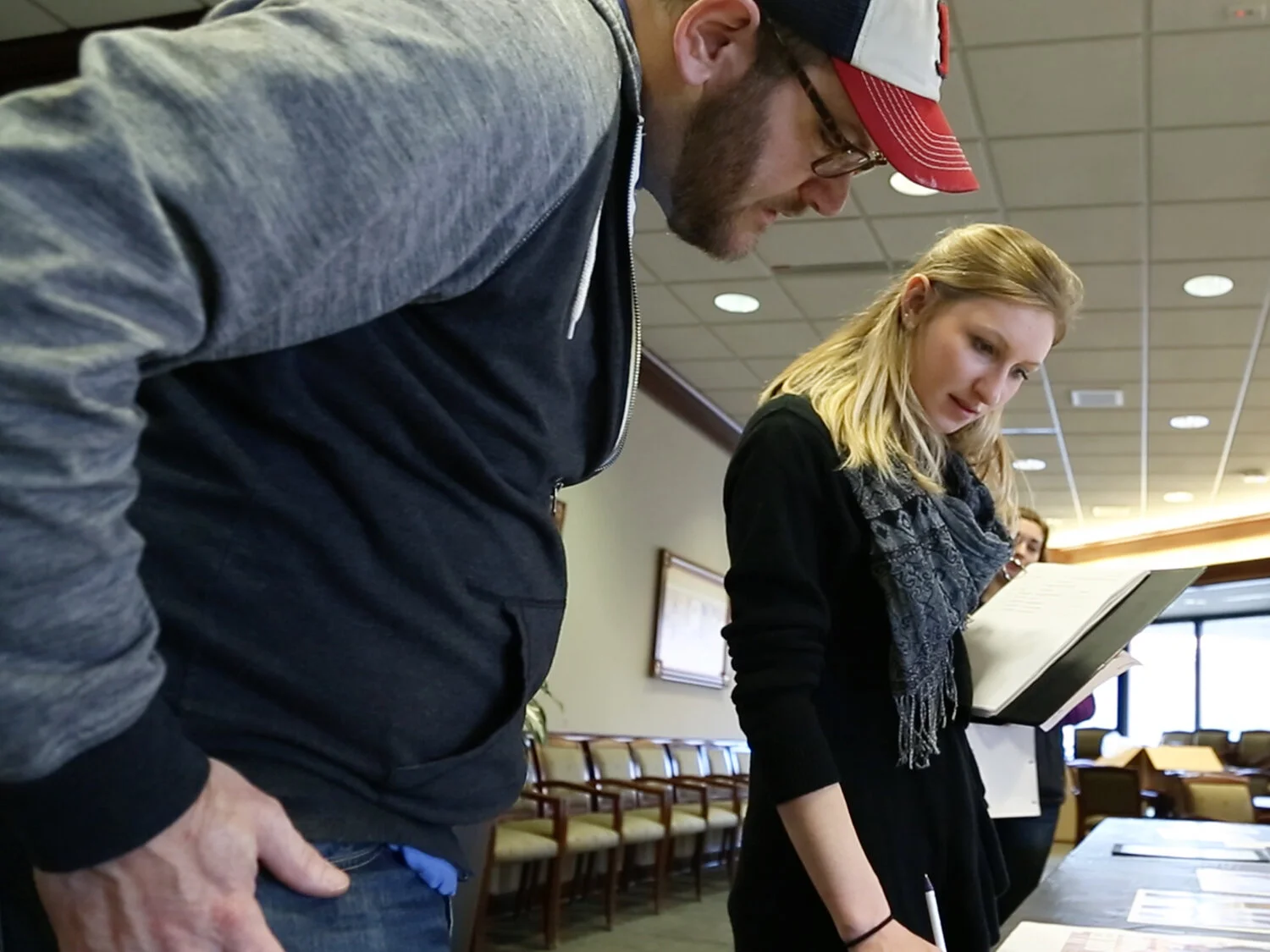HOW / St. Louis ADDYs
The following story originally appeared on the HOW Design website on March 1, 2016. In March 2019, HOW’s parent company filed for bankruptcy, and the website ceased to exist.
Lindenwood student Sierra Teson, right, shadows Blaine Loyd as he judges the St. Louis ADDYs.
Advertising Students Put Theory Into Practice In St. Louis
Last year, when I asked Joelle Riffle how young creative professionals could boost their value, she offered the following advice: “Everyone has something to give to others,” she said, urging aspirants to learn from those around them. “Everyone’s experiences and skills are valid, and being able to apply and develop them in service to others is fundamental.” Riffle also asked those benefiting from new expertise to pay it forward, saying, “When you explain something to a beginner, you are forced to interrogate and articulate how you know something and find a way to share that knowledge with another person.”
I was very fortunate to see both of those principles in action this January in St. Louis. Four of us — myself, Archer Malmo’s Blaine Loyd, Cactus’s Norm Shearer and Amazon’s David Glaze — were there to judge the city’s ADDY awards, a two-day marathon session spent evaluating nearly 600 entries across all advertising mediums. Something we weren’t expecting, however, made the entire process even more worthwhile: The presence of a dozen-plus fresh-faced students from Lindenwood University’s advertising program.
As we arrived at Anheuser-Busch headquarters to begin judging, Dr. Kristy Tucciarone, professor and program manager for Lindenwood’s Bachelor of Arts in Advertising, Public Relations: Corporate Communications sequence greeted us with a hearty, “Hello, I’m Tucc!” Then, Tucc (pronounced “Tooch”) introduced us to her students, who were excited enough about the industry to give up their weekends to join us. The best part: They weren’t just there to watch; students managed setting up the entries, maintained the flow of judging and shadowed us as non-voting observers while we judged.
“Judging the ADDYs is no small job,” says Loyd. “It’s repetitive and the process can be a huge grind. But then you're paired with a student and your job is tell them what you think and why. You explain how an ad had a great concept, but fell short somewhere in the execution and how heartbreaking and common that is in advertising. Before you know it, you're doing a better job, because this student deserves a better effort. It also gently reminds you to look at the work with fresh eyes, like the student standing next to you probably is.”
The fresh-eyed student standing next to Loyd was Lindenwood junior Sierra Teson, who hopes to work in nonprofit communications. “It was an incredible opportunity to discuss ideas and executions with the judges,” she says. “Hearing their perspective on what works and what doesn't gave me insight into what other professionals would look for in our work. I have always been fascinated by advertising and it was inspiring to see so many different submissions — and the endless possibilities they offered. I liked forming my own opinions of the entries and then comparing them to what the judges thought.”
Judging side-by-side with Teson, Loyd says, worked well because Tucc took care not to put too many guardrails on the process. “It's funny, because at first I wasn’t sure what I was supposed to be doing,” he says. “Was I supposed to act like a teacher? Or a mentor? Or should I just ask her what she thinks? Ultimately, the fact that we weren't given strict guidelines made that decision more natural. At first, we were both a little awkward, but we found our groove as we went along. If there was a good point that I thought might help Sierra in her career, I mentioned it. And she was quick to ask me why I liked or disliked an ad. I found myself asking her what she thought pretty often and her instincts were really good.”
Shearer sees the value in having students shadow judges. “They got two cool benefits: Exposure to potential employers and to network and ask questions about the industry,” he says. “And hearing our raw praise and critique of the work as we do the judging. That’s a great learning experience for a student to see firsthand how a veteran creative director analyzes and dissects work from all the angles of strategy, design, copy and ideation.”
Loyd, past president of AAF Memphis, echoes Shearer’s sentiments. “It might not be as obvious to students right away, but they're getting gold by being there during that candid discussion,” he says. “It might take years before they can get a creative director to talk like that in their earshot again. They also get to see that we're just humans, if older and less optimistic than they are. They might think our opinions are outdated or jaded — and they might be 100% right. But they get to see the kind of thinking that goes into deciding whether this type of person will like their book, hire them or like their idea for their first ad or campaign.”
Tucc has steadily grown Lindenwood’s program since her arrival in 2014. Her 120 students have responded, earning national awards, graduating with national honors, winning four gold ADDYs and competing in the American Advertising Federation’s National Student Advertising Competition. Tucc credits her local AAF chapter for much of this success. “Ad Club St. Louis affords my students the endless opportunities to learn, create and network,” she says. “As their professor, I also bring guest speakers to campus, arrange agency and corporate tours and facilitate their participation in various competitions. Shadowing judges as they analyze entries allows students deeper insight in the creative, writing, production and overall campaign process. I cannot duplicate this type of learning in the classroom — it’s over-the-top incredible.”
Teson appreciates her efforts. “Tucc is eager to find opportunities for her students,” she says. “She has offered many other activities for us in the St. Louis area and is always happy to help us add experience to our resumes.” Wilder Politte, another Lindenwood student on hand for judging and later for the awards ceremony, feels validated in his chosen course of study. “These experiences have really gotten me into advertising,” he says. “They have connected me to very important people in the industry in a short amount of time — making me less curious if I'm on the right track. This is the most I have ever been involved in the industry and I thank Tucc for all of these experiences.”
One of the best parts of having students so involved, for me, was how enthusiastic it made us feel about judging. The students benefited from our experience, sure, but it was also very obvious we were feeding off of their vitality. “I have always loved teaching,” Shearer says. “It was a great idea of Ad Club St. Louis to involve students. We all win: The students get to hear our critical thinking firsthand, and we get to witness their unbridled energy and passion for the business. Every generation has new, different and daring ideas. It was fun to be around that.”
Loyd, a veteran of both award show judging and industry advocacy, loved what he saw on display. “I’ve never seen student involvement like I saw in St. Louis,” he says. “And, frankly, I’m jealous of how talented, helpful and engaged the students were. I've been president of one AAF club and have judged the ADDYs in three other cities and what I saw in St. Louis was, by far, the best way to utilize student volunteers so that they actually got something useful and tangible out of the experience.”
Politte agrees, saying, “It was one of the coolest things I have done.”

